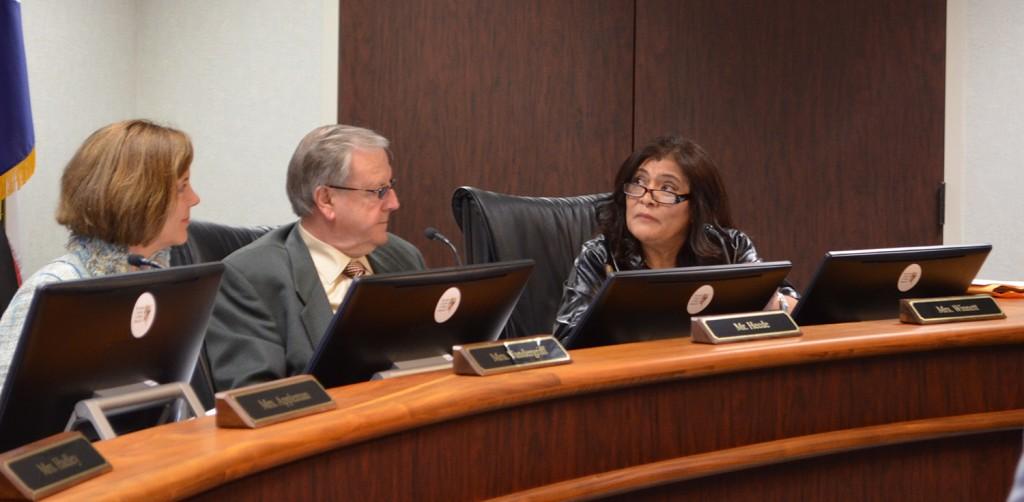By Kyle Huff/reporter
Students gained a better understanding of ways to protect the environment after five speakers addressed home horticulture, water resources, air quality and the Keystone pipeline during Environmental Awareness Day on NE Campus April 8.
Home Horticulture
With a population that is rising and a water supply that isn’t, people can turn to drought-friendly landscapes as an alternative, said Steve Chaney, a home horticulture extension agent from Texas A&M.
“The lawns during growing season use 60 percent more water in Texas than anywhere else,” he said.
Texas has a large abundance of untapped natural resources that were disturbed during the European migration, Chaney said. But those natural resources, if properly done, can be found and used in landscape design.
“A rancher in 1974 bought a ranch near Johnson City that had no water,” he said. “Now that same land has 14 springs and lakes because he found what was wrong and fixed what was already there.”
Some drought-friendly landscapes can be mowed just once a year. That helps the environment because some mowers emit 11 percent more pollution than a car, Chaney said.
“Native and adaptive plants are the way to go,” he said. “I use native and adaptive plants because they are very hardy, drought-resistant and aid in water conservation.”
When people use adaptive and native plants in their landscapes, they not only get the benefit of low maintenance, they don’t have to use pesticides and herbicides, Chaney said.
“When considering how you do a landscape, always do planning and design before you start,” he said. “Make sure and research what kinds of plants will best be suited to grow where you are planning on planting.”
One of the most critical pieces to a landscape is the addition of mulch, Chaney said. Mulch is a great way to help conserve water, and it reduces the heat in the ground by as much as 50 degrees.
“There are many resources available, and all you have to do is remember to look up Aggie Horticulture,” he said.
Air Quality
Particle pollution is leading to an increase in people having to make hospital room visits, Mark Allen from the Environmental Protection Agency said.
In 1970, Congress created the Clean Air and Water Act, which governs the entire country. Also, states, tribes and local governments play a large part in meeting the standards of the law, Allen said.
“Under the Clean Air Act, the EPA sets limits on air pollutants and how much can be in the air,” he said. “Individual tribes and states may have stronger laws, but not weaker.”
The EPA must approve state, tribal and local plans for lowering air pollutants, called state implementation plans and tribal implementation plans, Allen said.
“With regards to TIPs in the nation, the Navajo Nation is the only one to have one,” he said.
One of the most recent rules for the SIP requires permits on generators for small buildings, Allen said.
“Any new plans that might go into action, you can pull up on the EPA’s website, comment, and we will get back with you as soon as possible,” he said.
The EPA develops its rules based on primary pollutants in the environment: particle pollutants, ground-level carbon monoxide, sulfur-oxide and lithium, Allen said.
“Particle pollution is caused from plants burning gas three-fourths of the way, and the effect is a black soot that gets in your lungs,” he said.
Particle pollution/particulate matter is formed from motor vehicles, wood burning and primarily coal that is burned from industrial plants, Allen said.
“Fine particles can remain suspended in the air and carry for long distances,” he said. “Over 20 percent of particles that form the haze over the Rocky Mountains and the National Parks has been estimated to come from over 100 miles away.”
Out of all of the regions, Big Bend has the cleanest air, Allen said.
“There has been climate change since the very beginning of time, but the Industrial Age has caused the climate to increase more and more,” he said.
Different people around the world say that climate change happens for different reasons, Allen said. If representatives from National Oceanic and Atmospheric Administration and NASA were asked, they would say people are the cause.
Keystone Pipeline
The Tar Sands mining project is the biggest and most environmentally destructive project on the planet, said Jodi Voice from the Texas Action Coalition for the Environment.
“The pipeline is sponsored by a foreign corporation with the interest of exporting oil across the pipeline from Canada to the Gulf of Mexico,” she said.
To complete the pipeline project, Americans will have to give up millions of acres of land and destroy Nebraska’s Ogallala aquifer, the nation’s largest known aquifer, Voice said.
“The pipeline will affect the DFW metroplex because they will reuse two outdated pipes that are already here,” she said. “This is a problem because the pipes have a history of leaks and spills from bad welding.”
The whole problem with the Keystone pipeline project starts with the Tar Sands mining in Canada, Voice said.
“Unlike the supervision the EPA does for the environment here in the U.S., Canada does not have any kind of regulation that will protect the environment,” she said.
The Tar Sands have hundreds of mega-dump trucks tearing out the acreage, hauling and processing the materials over hundreds of miles every day, Voice said.
“Since the pipeline project has started, toxic wastes have started seeping into the water and air,” she said. “As a result, there have been a lot of abnormalities, deformities and cancers found in the people and wildlife near Alberta.”
Animal life near the extraction sites have suffered effects from fish not having gills to deer having cancer, Voice said.
“Beaver Lake Cree First Nation has experienced a 74 percent decline of Cold Lake caribou herds and a 71 percent decline of the Athabasca herds,” she said.
With the growing decline of animals and wildlife near Cold Lake and Athabasca, it is expected that the caribou will be extinct by 2040, Voice said.
“The Reject and Protect is based on the Cowboy and Indian Alliance, which is an allegiance of ranchers and tribes near the pipeline that will work together and not let the pipeline gain access of their lands,” she said.
The best thing that people can do regarding the Keystone pipeline is to get educated on the matter, Voice said.



























